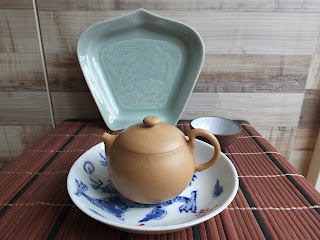I managed to make time to visit the Malaysia tea expo last week. This tea expo was held at Viva Mall, Kuala Lumpur from 8 -12 Dec.
I was extremely happy to meet my Malaysian tea drinker friends and tea drinking groups. It was something like a old class reunion; catching up with each other and comparing notes on our tea and recent purchases and having gift exchanges with each other.
I was able to be an 'early bird' to the tea expo on opening day and I managed to snagged a few promotional items for early visitors to the fair. You can see from pix 2 that I got a couple of 90s Sea Dyke Tie Guan Yin teabags and 2 old unused 80s tea bowls. Teabags? Yes! And they are good. Old Chinese tea bags especially the Sea Dyke brands brew up an old medicinal tea taste and aroma which I simply adore. I intend to give one of these boxes to my local teabag collector friend. The 2 80s bowls was advertised as tea bowls. They were, I recalled, more commonly used as rice bowls rather than tea bowls. Chinese porcelain collectors will recognised the chop marks as from Jingdezhen. A happy purchase.
I had the privilege to sample teas while at the expo. The new 1959 Xiaguan recipe tuo (250g) is blended with banzhang and yiwu tea leaves. While at the Xiaguan booth, I was especially impressed with the 2007 iron cake that had a unique smooth sweetness which I liked. I will add that iron cake to my shopping list on my next trip.
I was also invited to sample the Taetea (aka Dayi) 2017 super premium Xuan Yuan Hao pu erh tea. With a asking price more than US$300 per cake at the fair, I sensed this cake will be an investment/speculative cake, a 'bitcoin' cake if you can call it. The Dayi manager told me that this cake had Banzhang material inside and the accompanied literature that came with this cake also indicated that there was a blend of old bulang tea leaves as well.
I received a early Christmas gift of a 1999 Xiaguan tuo from a Malaysian tea buddy. Thank you if you are reading this. And.....I bought a teapot tray before I left the fair. The dark green jade colour was simply too pretty to pass up. I could hear the tray calling out to me to buy it......must be the due to the new Star Wars movie coming out this weekend. Light sabres and Chinese tea? Happy Holidays to all my readers.


















































